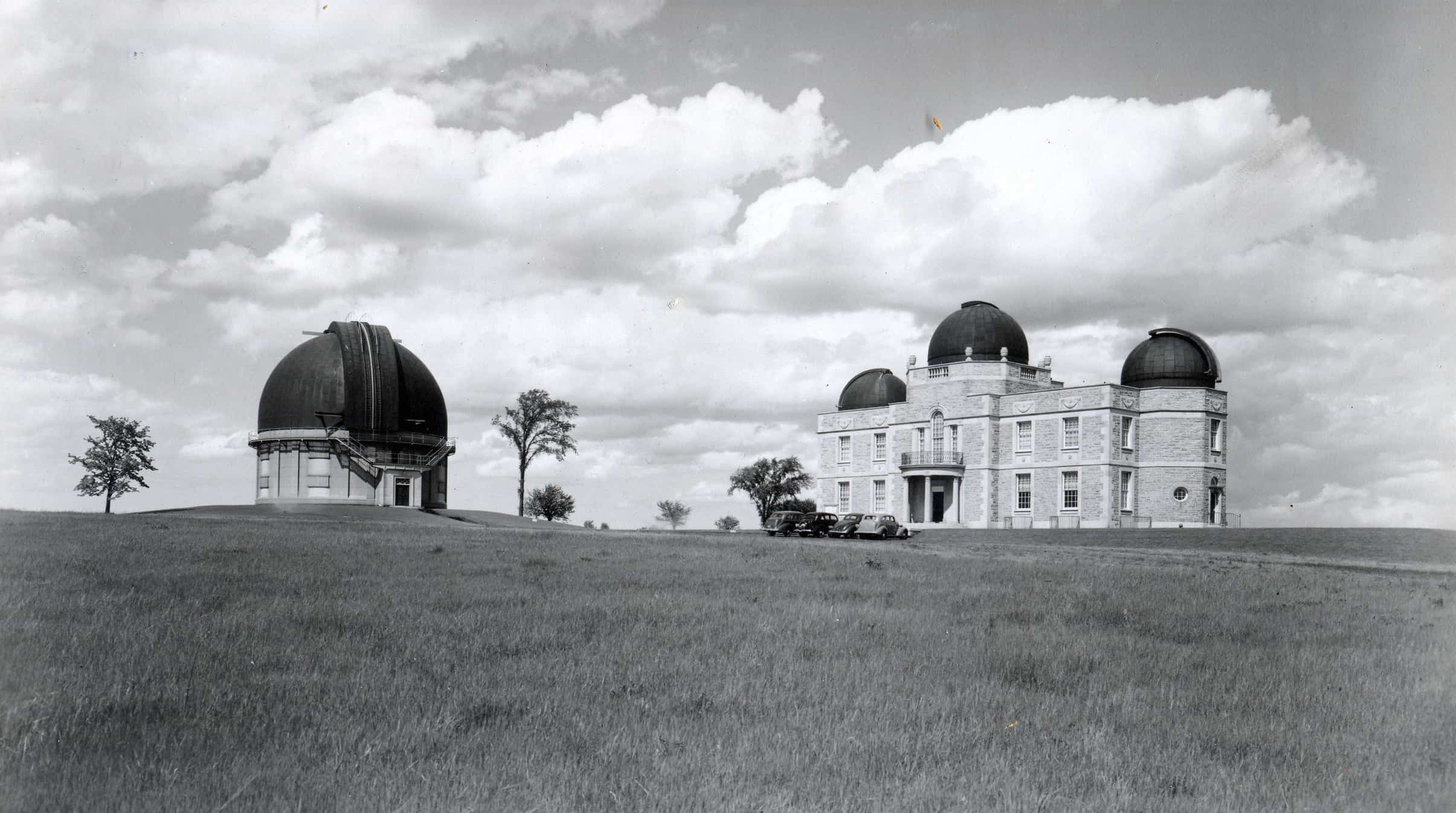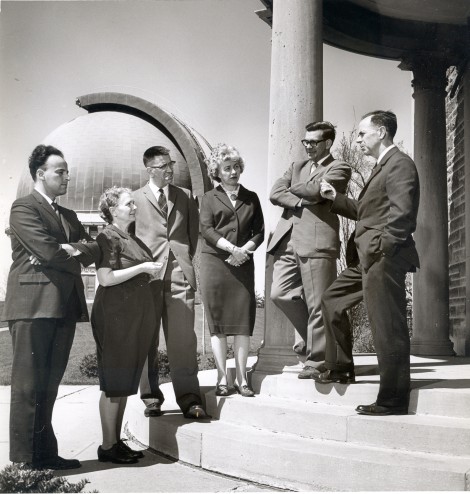In 2008, decades after it was entrusted to the university by the Dunlap family, 79 hectares of land in Richmond Hill were sold to a private developer for $70 million dollars. The deal, which ran afoul of the original terms of the endowment, was signed over objections from astronomers within the university, community activists in Richmond Hill, and a Dunlap heiress, who put up a 20-year fight to preserve her grandfather’s legacy.
In 1922 David Dunlap, an amateur astronomer and wealthy mining magnate, attended a lecture given by professor Clarence Chant, founder of the University of Toronto’s astronomy department. The lecture marked the beginning of a long and fruitful partnership, and over the next decade, Chant and Dunlap worked together to bring a world-class observatory to the university.
In 1927, the Dunlap family gifted the university 79 hectares of land, including a farmhouse that predated Canadian Confederation. After Dunlap’s death in 1924, his wife, Jessie Dunlap, continued to work with Chant and on May 31 1935, Jessie Dunlap cut the ribbon on the David Dunlap Observatory. The observatory’s telescope was, and remains to this day, the largest in Canada, ensconced within an 80-tonne copper dome.
“The observatory when it was first constructed was a world leading instrument, there’s no question of that,” says Pekka Sinervo, who was dean of Arts & Science in 2007 in the lead-up to the eventual sale of the property.
In the nearly 70 years of the university’s ownership, the observatory was the site of historic accomplishments in astronomy: the first discovery of a black hole, the discovery of several solar systems, and the most comprehensive globular cluster catalogue assembled at the time.
But in 2008, after a protracted legal battle with the Dunlap family, the University of Toronto’s Governing Council voted overwhelmingly to declare the David Dunlap Observatory lands “surplus.” The university proceeded to sell the land to private developer Corsica (Metrus) Development.
DIVIDE AND CONQUER
When the land was originally gifted to the university, the deed, a copy of which was obtained by The Varsity, stated that if the university were to “use the land for purposes other than research,” it would revert to Dunlap’s heirs.
To circumvent this clause and proceed with the sale, the university first courted Dunlap’s descendants, and then reportedly engaged in a protracted legal war of attrition. The three Dunlap heirs, David Dunlap III, J. Moffat Dunlap, and Donalda Robarts, grandchildren of David and Jessie Dunlap, would have jointly held the title for the land if the university had proceeded without their permission. David and Moffat Dunlap capitulated to an alteration of the bequest after a few months, but Robarts held out.
According to an account given to the National Post in 2008, Donalda and her husband, Richard Robarts (cousin of John P. Robarts, the Ontario premier after whom the central library at U of T is named) were courted during dinners at the Royal Canadian Yacht Club and were offered one million dollars for each of the Robarts’ seven children. Donalda Robarts was not available for a comment at press time.
“It took four years and hundreds of thousands of dollars before she capitulated,” says Karen Cilevitz, chair of the David Dunlap Observatory Defenders. “She was in her 70s. It was exhausting.”
The lawsuit was settled out of court in 2007 and the records of the case are sealed.
Last year, David and Moffat Dunlap received honourary degrees from the university for “contributions to astronomy.”
Donalda Robarts received no such honour. “She was the one who held out for four years,” Cilevitz points out.
A spokesperson for the university refused to confirm or deny any details about the lawsuit, saying only that, “the university proceeded with the sale of the property with the full agreement of the Dunlap Family.”
A FAIR DEAL?
A 2007 article in the Toronto Star quoted an unnamed university official as saying the land was worth $100 million. Ultimately, the university sold the property to Corsica for a price tag of $70 million.
“I would be interested to know why we settled for $30 million less,” said PC Choo, a Governing Council member representing administrative staff, in an interview with The Varsity. Choo was one of two governors to vote against the sale.
Choo’s objections were twofold: he believed there was still valuable research to be done at the site, and he was concerned that a number of his colleagues would lose their jobs. Ultimately, one administrative staff member retired and two were laid off as a result of the observatory’s closure.
Asked about the discrepancy between the unnamed official’s first statement and the eventual price, university spokesperson Laurie Stephens said “the university is confident it got the best possible price.”
THE SCIENCE BEHIND THE SALE
Two radically different perspectives have emerged about the scientific rationale for the sale.
The university contends that light pollution from the GTA means the telescope can no longer be used for research, as the Dunlap family had specified in the bequest.
Dr. Ian Shelton is vice-chair of the David Dunlap Observatory Defenders. He passionately disagrees with the university’s rationale. “Its basically a smear campaign to make everybody feel that it was the right thing to do to close the observatory,” said Shelton. “To say that it was for financial reasons wouldn’t have flown.”
The observatory was used primarily for spectroscopy. Light is taken from only the smallest part of the sky possible, according to Shelton so light pollution is far less important than in other kinds of astronomical research. Richmond Hill has had a bylaw for decades that limits light pollution surrounding the observatory.
“The argument that there was no research value is absurd,” says Shelton.
“The telescope cost $800,000 annually to operate; it was no longer cost effective” said professor Peter Martin, who was chair of the Astronomy & Astrophysics Department at the time.
Martin explains that the money used to operate the observatory, as well as the $70 million from the sale, have now been funneled into the Dunlap Institute, “whose sole goal is to carry on the legacy [of David Dunlap].”
RICHMOND HILL
The land donated by the Dunlap family is located in Richmond Hill. As the growing town encroached upon, and then surrounded the observatory’s acreage, its value increased.
“The town did want to engage in a discussion with the university, and the university had already made a decision,” said Anna Bassios, commissioner of planning and regulatory services for Richmond Hill. “The university’s sole interest was getting the greatest amount of financial return.”
Bassios’ sentiments are echoed by many of those following the sale. Cilevitz argues that the university decided to sell the land well before formally putting it up for surplus, but instead of engaging in conversations with the community “they began a process of attrition, they wouldn’t repair or replace things, or professors; by the time they closed the doors there were only a handful of professors left.”
According to testimony by Dr. Tom Bolton, a professor emeritus in the Department of Astronomy & Astrophysics whose work at the observatory led to the discovery of Cygnus X-1, the first black hole identified, testified at an August hearing before the Ontario Municipal Board that it “cannot be understated” that the decision taken by the U of T was a “business decision, not an academic one.”
Bolton noted the U of T did “not consult with the Department of Astronomy & Astrophysics” and that they were simply “told” by the university that a decision had been made to sell the site.
“It is viewed by us, by Donalda, by anybody who knows this story as a breach of public trust,” concludes Cilevitz.



